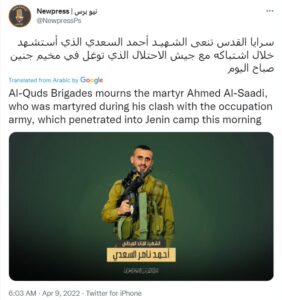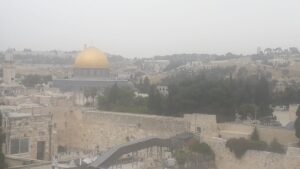- 319
- 320SHARES
Faith is not necessarily informed nor enriched by facts, and it can flourish just fine without them. Ethical journalism, in contrast, is inherently tied to facts; its very survival is dependent on the rigorous adherence to facts.
When it comes to the Temple Mount, Judaism’s most sacred site and the third most-holy place in Islam, Reuters trips up on the facts about the faithful.
First, the April 21 article by Suleiman Al-Khalidi (“Arab League urges Israel to stop Jewish prayers at Al-Aqsa mosque“) grossly misleads about the location of the two Jewish temples writing: “the site is known to Muslims as Haram al Sharif (Noble Sanctuary) and to Jews as the Temple Mount, the holiest site in Judaism, where they believe two ancient temples were located.”
That the two temples were located on the Temple Mount is not a matter of Jewish faith; it’s archeological fact, the historic record.
As a critical Oct. 13, 2015 New York Times correction made clear:
An article on Thursday, with the headline “Historical Certainty Proves Elusive at Jerusalem’s Holiest Place,” examined the scholarly debate about two ancient Jewish temples on the Temple Mount, a site sacred to Jews, Muslims and Christians. While the article laid out the history of the Jewish temples and the archaeological and historical evidence about them, the headline and a passage in the initial version of the article implied incorrectly that questions among scholars about the location of the temples potentially affected Jewish claims to the site and Israel’s broader assertion of sovereignty over Jerusalem. In fact, as the article was later corrected to clarify, the scholarly debate is a narrower one, focused on the precise location on the Temple Mount where the long destroyed temples once stood. All versions of the article should have made clear that the archaeological and historical uncertainties about the site — unlike assertions by some Palestinians that the temples never existed — do not directly challenge Jewish claims to the Temple Mount.
Reuters own coverage in the past has rightfully reported as fact that the Temple Mount “was home to the Jewish temples of antiquity.” Reuters’ new faith-based formulation — “they believe two ancient temples were located” there — is a repudiation of fact in favor of narrative reporting, which, like faith, is not confined by the strictures of facts.
To its credit, however, Reuters’ April 21 story did note that the site is Judaism’s most holy place, avoiding a past pitfall. Reuters’ April 23 article, in contrast (“Palestinians clash with Israeli police at Jerusalem holy site, 57 injured“) displays an egregious double standard, noting that the site is the third-holiest in Islam while neglecting to mention that it is the most sacred site in Judaism. It selectively reports: “Palestinians accuse Israel of restricting Muslim worship at Al-Aqsa – the third-holiest site in Islam . . .”
The headline of the April 21 story — “Arab League urges Israel to stop Jewish prayers at Al-Aqsa mosque” — is also wildly misleading. Jewish prayer is not permitted on the Temple Mount, and while a small minority of individual Jewish visitors illegally mutter prayers under their breath, they do not do so “at Al-Aqsa mosque” but outdoors on the Temple Mount plaza.
B’Tselem‘s detailed data for Palestinians killed by Israeli security forces in the West Bank from March 1 through March 31 includes 11 names, of which two were actually killed as the Palestinian assailants carried out attacks in Jerusalem — not the West Bank (‘Abd a-Rahman Jamal Muhammad Qassem and Karim Jamal Muhammad Isma’il al-Qawasmi).
B’Tselem’s data also includes Nidal Juma’ Jafara, who stabbed a civilian on a bus in Gush Etzion, and then was shot dead by an armed civilian. So he wasn’t killed by Israeli forces during a raid. Of the remaining eight killed by Israeli troops in the West Bank, the vast majority were killed as they carried out attacks on Israelis. For instance, Nader Haitham Fathi Rayan reportedly aimed his gun at troops; ‘Alaa Muhammad ‘Abd al-Qader Shaham was shot while throwing a door off the roof of a building onto retreating soldiers; Yamen Nafez Mahmoud Khanafsah, Ahmad Hikmat Ahmad Seif, and Muhammad Rizeq Shihadah Salah threw Molotov cocktails at Israeli forces, Bakir Muhammad Musa Hashash opened fire on Israeli troops, and so on.
 The approximately dozen Palestinian casualties in April followed the same pattern; the vast majority were engaged in attacks on Israelis when they were killed. Maha Kazem Awad al-Zaatri stabbed a Border Policeman in Hebron (that wasn’t during a raid); Ahmed Yunis; Sidqi al-Atrash threw a firebomb; three Islamic Jihad members were killed April 2 in a gunfight, and so on. CAMERA’s Gilead Ini previously detailed the circumstances of additional casualties from the last two months:
The approximately dozen Palestinian casualties in April followed the same pattern; the vast majority were engaged in attacks on Israelis when they were killed. Maha Kazem Awad al-Zaatri stabbed a Border Policeman in Hebron (that wasn’t during a raid); Ahmed Yunis; Sidqi al-Atrash threw a firebomb; three Islamic Jihad members were killed April 2 in a gunfight, and so on. CAMERA’s Gilead Ini previously detailed the circumstances of additional casualties from the last two months:
Ahmad Sa’adi was a terror commander for Islamic Jihad, and was killed while attacking Israeli soldiers. Shawkat Kamal Abed was said to be killed “during clashes.” Fayaz Hamayel was killed “during clashes.” Omar Muhammad Alyan fell “during clashes.” Maha Zaatari was killed after stabbing an Israeli soldier. So was Abdallah Taysir Srour. Muhammed Ghnaim is said to have been throwing Molotov Cocktails, as were others among the Palestinian fatalities. Islamic Jihad operatives Khalil Tawalbeh, 24, from Jenin, Saif Abu Libdeh, 25, from Tulkarm, Saeb Abahra, 30, from Jenin were killed during a gunfight with Israeli soldiers.
The April 15 article, “Analysis: Jerusalem clashes raise fears of wider conflict,” follows the same mold as Reuters’ April 21 article, casting assailants as victims. Henriette Chacar, Ali Sawafta and Nidal Al-Mughrabi wrote: “The Israeli army has killed 40 Palestinians this year . . . ”
In contrast to Reuters, Agence France Presse reporting this week commendably acknowledges the fact that the vast majority of Palestinians killed were assailants: “Attacks by Palestinians and Israeli Arabs have since late March killed 14 people in Israel, while 24 Palestinians have died, including perpetrators of attacks and also in raids by Israeli security forces in the occupied West Bank” (“Israel says committed to status quo at Jerusalem holy site,” April 24).
The abandonment of ethical journalism in favor of partisanship reflects the open embrace of anti-Israel narrative which, like faith, is not dependent on facts. Hundreds of journalists against journalism sanitize the toxic paradigm as “contextualized truth.” Reuters’ recent hire, Henriette Chacar, is an adherent to the conviction that mainstream media coverage should be filtered through the (false) lens of Israel as a pariah state. Asked in an interview whether Palestinians feel emboldened by the support for the (baseless) accusation that Israel is an “apartheid” state, Chacar responded enthusiastically about what she sees as an increasing freedom to defame Israel:
One of the ways that we’re feeling it is in what we’re being allowed to say in international news media, terms like “ethnic cleansing” and “settler colonialism” that were sanitized, both in edited print pieces and interviews and now we’re seeing them make it through the edits, which I think is a very interesting process, very exciting process that we’re able to use our own language to describe our reality. (London Review of Books podcast, May 21, 2021)
 To that end, Chacar praised comedian John Oliver’s vitriolic and unhinged diatribe on Israeli “apartheid” and “war crimes” as doing a “better job providing context than seasoned journalists.”
To that end, Chacar praised comedian John Oliver’s vitriolic and unhinged diatribe on Israeli “apartheid” and “war crimes” as doing a “better job providing context than seasoned journalists.”
With the rise of a young generation of journalists against journalism, fact-based ethical journalism gives way to vitriolic partisan convictions.

